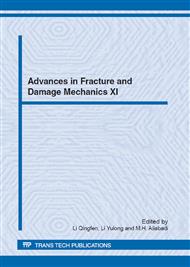p.13
p.17
p.21
p.25
p.29
p.33
p.37
p.41
p.45
Fracture Toughness of PIR Foams Produced from Renewable Resources
Abstract:
Rigid low-density closed-cell polyisocyanurate (PIR) foams are used primarily as a thermal insulation material. Traditionally, they are manufactured from constituents produced by petrochemical industry. Introducing renewable materials in PIR formulation brings definite economical and environmental benefits. Fracture toughness of PIR foams obtained from renewable resources (with the polyol system comprising up to 80% of rapeseed oil esters) and petrochemical PIR foams has been characterized experimentally, by compact tension tests, for mode I crack propagation along the rise direction of the foams.
Info:
Periodical:
Pages:
29-32
Citation:
Online since:
November 2012
Authors:
Keywords:
Price:
Сopyright:
© 2013 Trans Tech Publications Ltd. All Rights Reserved
Share:
Citation:


